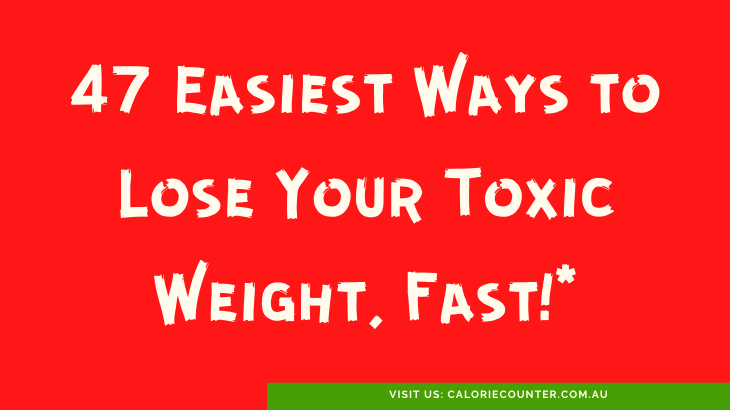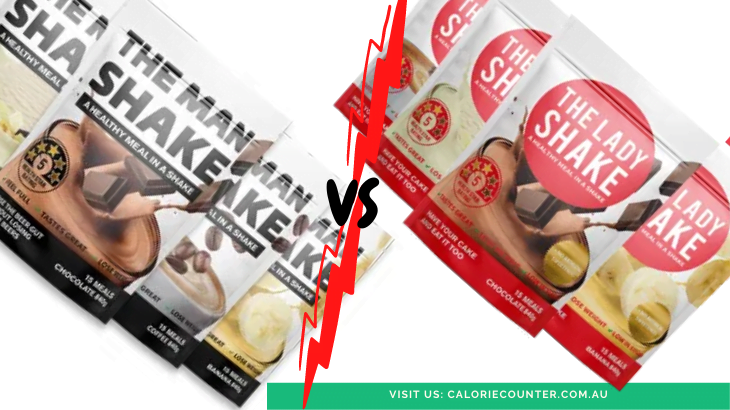Emulsifier 471 is a common food additive, but what exactly is it? What are the emulsifiers (or stabilizers) represented by codes 471, 322, 491, and 433 made of? You simply cannot avoid emulsifiers in processed foods because they are in almost everything. Are some emulsifiers bad for your health? Let’s get some answers!
What is an Emulsifier?
To emulsify means to successfully mix liquids which don’t usually mix. The obvious example is water and oil. Usually, oil just sits on top of water when it is poured in, stubbornly refusing to mix. However, give it a good stir or shake and the oil breaks up into dispersed globules.
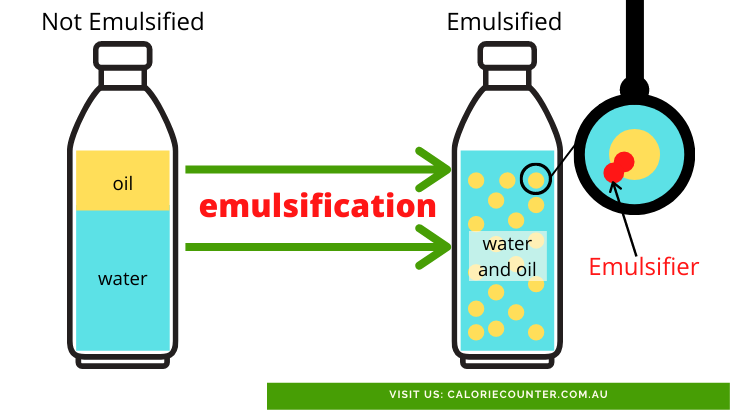
The small globules spread evenly throughout the water before floating back to the surface and re-forming a single oil layer. In the mixed state, the water and oil are said to be emulsified.
They form an emulsion through emulsification, a process sometimes enabled by an emulsifier.
The word “emulsion” means “to milk” in Latin, referencing milk, perhaps the world’s most common emulsion of oil and water.
Emulsified Food is High Calorie
Emulsions are common in naturally found, home-prepared, and industrially manufactured foods – a simple emulsion is vinaigrette prepared by simply whisking oil and vinegar together. By far, the most common type of emulsion includes oil, for example milk, mayonnaise, ice-cream, cake batter, peanut butter, margarine, and mashed potato. Thus, since oil/fat is calorie-dense, emulsified foods tend to be almost universally high in calories.
What do Emulsifiers Do?
In the case of our homemade vinaigrette, the emulsion is unstable and will soon separate. To make the oil and vinegar stay mixed, you can add a chemical which prevents the two constituents from going their separate ways. Such a chemical is known as an emulsifier. A common emulsifier in every kitchen is lecithin, found in egg-yolk. Whisking an egg yolk along with the oil and vinegar turns unstable vinaigrette into sturdy mayonnaise, courtesy of the lecithin.
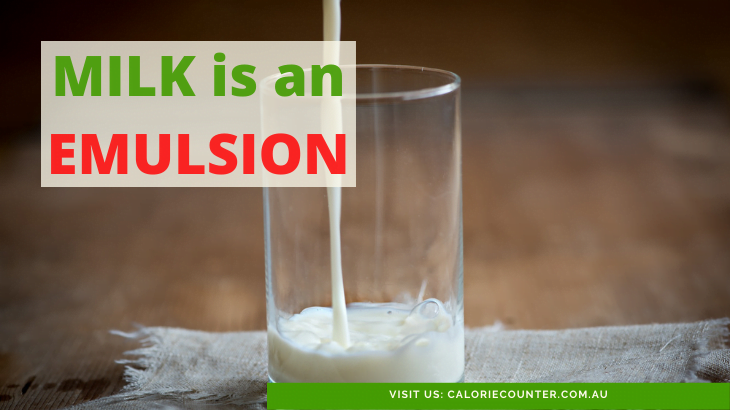
Different emulsifiers work in several alternative ways. Some physically link oil globules to their surroundings by “holding on”. Others break surface tension to allow things in water to get “wet” (soap is an emulsifier). Yet others form barriers around oil globules, so the water and oil don’t contact each other. Depending on the use case, certain emulsifiers work better than others.
Emulsifiers and Health
In the realm of processed foods, emulsifiers are food additives. As such, they must be clearly labelled, and only statutorily approved types may be used. At an industrial scale, simple unprocessed emulsifiers like whole raw egg-yolks are very rarely used. Instead, emulsifiers are the result of multi-step, sometimes proprietary chemical processes.
Some industrial emulsifiers have been linked to adverse health effects. Studies indicate that chemicals like carboxymethylcellulose, polysorbate, and carrageenan cause a significant immune system response resulting in inflammation of the gut. It is the sort of problem that does not usually land a sufferer at the doctor’s office, it is just a niggling discomfort which can gradually build up over time. More disturbingly, some research implicates certain emulsifiers with an increased cancer risk.
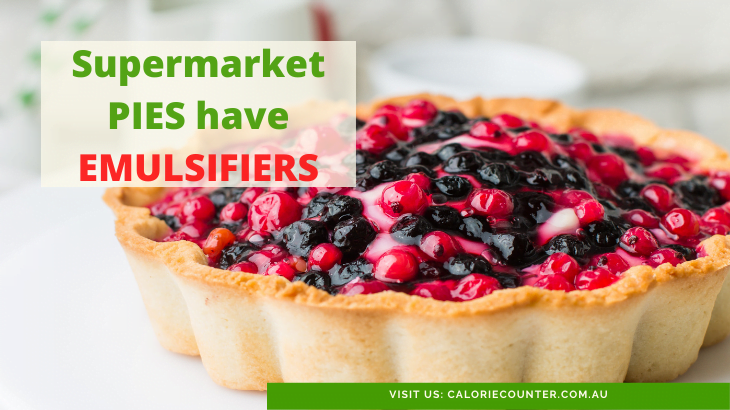
Thickeners, Stabilizers, or Emulsifiers?
In the world of industrial food additives, thickening, stabilising, and emulsifying are defined differently. However, the lines between the three are blurred because many substances perform all three roles while thickening, stabilising, or emulsifying. For example, Xanthan gum is classed as a stabiliser even when it effectively emulsifies the ingredients in pie filling. Is it an emulsifier stabiliser which thickens, or it is a stabilising thickener which emulsifies? For everyday laypeople like us, all three types of food additives can be usefully grouped together.
Commercial Emulsifiers and their Codes
The emulsifier codes on food labels are useful only if you know which chemicals they signify, and what those chemicals do. These codes are almost universally recognised around the globe and are preceded by an “E” in products sold in Europe. Here is the list of common emulsifiers by code, with some emulsification food examples:
Emulsifier 322: Lecithin
Lecithin is the name given to any naturally occurring yellowish-coloured fatty substance which attracts both water and oil. An example is the phosphatidylcholine in egg yolk, but there are many different lecithins in a wide range of plants and animals. Much of the lecithin additive in food today is processed from soybeans.
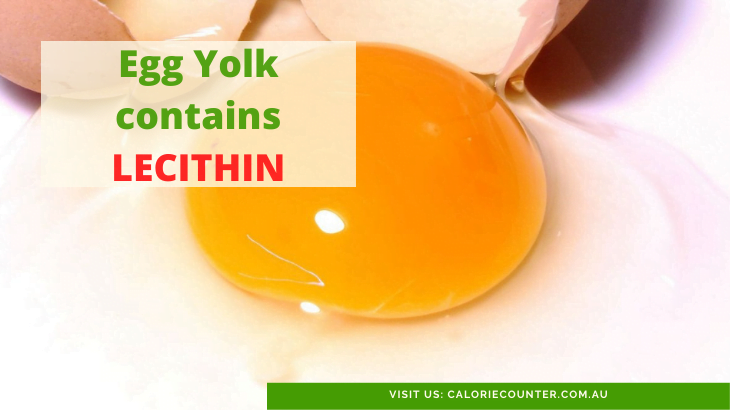
Lecithin is added to an enormous number of different foods, including margarine, chocolate, and cooking oil, which means that it ends up in everything made with these basic ingredients.
Lecithin is used as a dietary supplement to deliver the essential nutrient choline and potentially benefit acne sufferers. Some research indicates that eating too much soy lecithin can cause depression.
Emulsifier 400, 401, 402, 403, 404, 405: Alginic Acid
Alginic acid is extracted from brown seaweed and used in drinks, ice cream, jellies, and weight-loss supplements. It is also used in the cosmetics, textiles, paper, and fireproofing industries. It absorbs water quickly and is used in anti-acid reflux medications like Gaviscon. The codes 401-405 are different chemical configurations of Alginic Acid.
Emulsifier 406: Agar
Agar is a type of jelly processed from red algae. It was discovered by a Japanese innkeeper in 1658 when he tossed out some old seaweed soup then noticed that it had transformed to jelly the next day. It contains a massive 80% dietary fibre and is used to bulk foods up without increasing calories. If you like the “pearls” in bubble tea, you like agar.
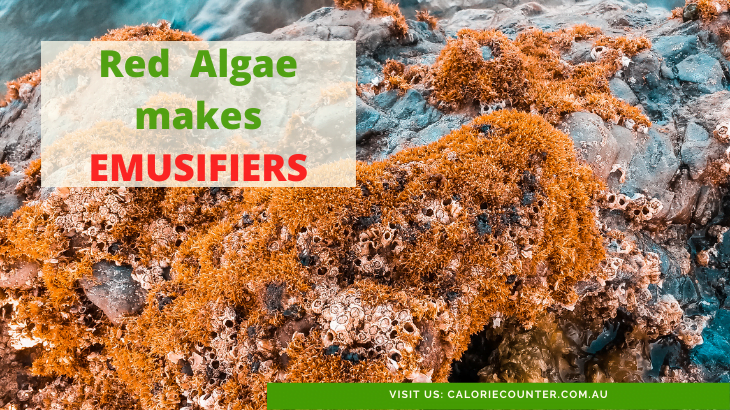
Emulsifier 407, 407a: Carrageenan
Carrageenan is a gel extracted from red seaweed. It forms powerful bonds with food proteins and is widely used in meat and dairy processing. Most carrageenan is made in the Philippines and China, where the seaweed is treated with hot alkali (potassium hydroxide) and concentrated by evaporation.
In addition to widespread use in the meat and dairy industry, carrageenan is also used in toothpaste, beer, soy milk, shampoo, and personal lubricants. Baby formula, shoe polish, diet soft drinks, pet food, sauces, and vegetarian “meats” are also use cases.
Carrageenan is one of the potentially risky emulsifiers we mentioned earlier on in this article. It has been linked to gut inflammation and colon cancer in some studies.
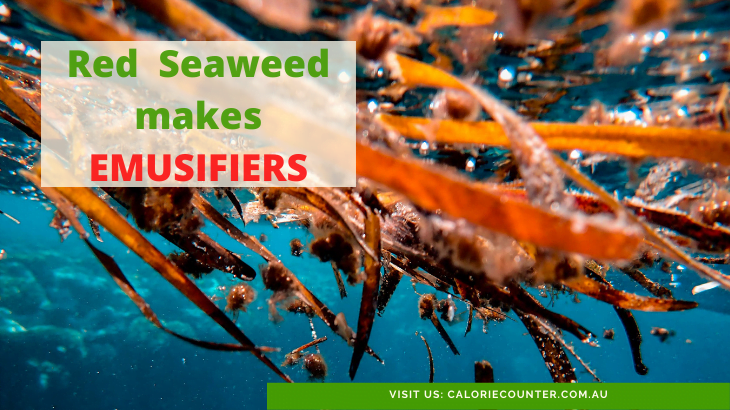
Emulsifier 409: Arabinogalactan
Arabinogalactan is a common plant gum which can be extracted from many common plants and microbes. Its use in nature is to glue damaged plant tissue (if you’ve ever seen gum oozing from a cut in tree bark you get the idea). It is used in many foodstuffs, pharmaceuticals, cosmetics, animal feeds, and construction materials.
Emulsifier 410: Locust Bean Gum
Locust Bean Gum, also known as LBG, carob gum, carob bean gum, or carobin is a gum derived from the seeds of the carob tree. Most LBG comes from Portugal and Italy. The carob bean pod is known in some circles as the poor man’s chocolate because it is sweet and has a taste reminiscent of cocoa. The LBG itself is produced from the seeds of the pod, and used in various foods as well as insecticides, paper, mining products, and cigarettes.
Emulsifier 412: Guar Gum
Guar gum, also known as guaran, is a product of guar beans from India and Pakistan. The process of extracting guar gum from the beans is a multi-stage manufacture which sometimes includes modification by enzymes. Guar gum is extensively used in the hydraulic fracturing industry (“oil fracking”), as well as foods and explosives. When used in food, it has eight times the thickening power of starch. Guar gum is the main ingredient in many brands of laxative.
Emulsifier 413: Tragacanth
Tragacanth is a simple plant gum taken from the sap of the Goat’s Thorn weed. It is also known as Shiraz gum, or gum dragon. In the Middle East, tragacanth is a traditional medicine used to treat diarrhea and coughs.

Emulsifier 414: Acacia Gum
Acacia gum come from the sap of acacia trees, so it is one of the vegetable emulsifiers. It is also known as gum Arabic, Senegal gum, and gum Sudani, amongst other localised names. Originating from Africa, acacia gum has been used by humans for thousands of years. It is widely used in the food industry, most notably in chewing gum, lollies and confectionery, and pie fillings. A natural prebiotic, acacia gum is fermented in the gut by “good” bacteria. Excessive consumption causes flatulence.
Emulsifier 415: Xanthan Gum
Xanthan gum is one of the few foods in the English language starting with the letter X. First discovered by the US Department of Agriculture in the 1960s, it is produced by Xanthomonas bacteria on an industrial scale. Xanthan gum is widely used in the food, oil-drilling, and cosmetics industry. It is an added to dressings, sauces, spices, beverages, meat, baked goods, confectionery, and many other processed foods.
Xanthan gum has been linked to respiratory problems in adults and necrotizing enterocolitis in infants.
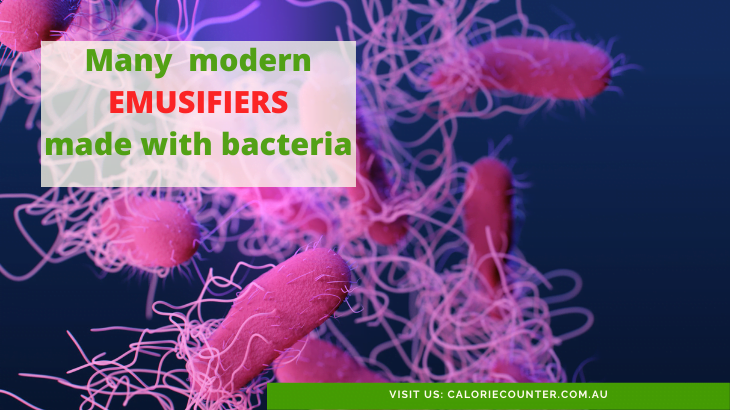
Emulsifier 416: Karaya Gum
Karaya gum is like tragacanth (code 413), in that it is a natural vegetable gum simply extracted from a tree sap in India.
Emulsifier 417: Tara Gum
Tara gum comes from the seeds of the Tara tree from South America. It is used as a more “natural” alternative in processed foods like ice-cream, baked goods, and confectionery. In Peru, Tara tree pods are used as traditional medicine for stomach aches and fever.
Emulsifier 418: Gellan Gum
Gellan gum, like xanthan gum, is derived from a US-scientist-discovered bacterial product. The bacteria in question, Sphingomonas, was found growing on a lily pad in a random pond. Gellan gum is widely used as a substitute for gelatine in confectionery, flavoured milk, and ice cream. Unlike gelatine, it remains jelly even after heating and churning. If you have tried “flaming ice cream” at a fancy restaurant, it is thanks to the gellan gum added to it.

Emulsifier 419: Gum Ghatti
Also known as Indian gum, gum Ghatti is yet another tree-sap derived natural gum which has been used for thousands of years. The tree is the Axlewood, or Bakli tree native to India, Nepal, Sri Lanka, and Myanmar.
Emulsifier 420: Sorbitol
Sorbitol is a type of sweet alcohol, usually manufactured from corn starch, which the human body metabolises very slowly. In syrup form, sorbitol is a common emulsifier and humectant (moisturiser) added to peanut butter, biscuits, bread, and jam. Sorbitol has a laxative effect, to learn more read our post on prunes.
Emulsifier 424: Curdlan
Curdlan is a gel produced by Agrobacterium bacteria which were initially discovered in human faeces.
Emulsifier 425, 425i, 425ii: Konjac
Konjac, also known as devil’s tongue, voodoo lily, snake palm, and elephant yam, is derived from the corm or tuber of the Konjac plant. It has been eaten in Japan since the sixth century. As a food additive, it is an ingredient in weight-loss products, jelly-like confectionery, and vegan “seafood”.
Emulsifier 432, 433, 434, 435, 436: Polysorbate
Polysorbates are made industrially through a chemical reaction between sorbitol (see code 420) and ethylene oxides. They are a chemical step further from sorbitol than sorbitan (see codes 491-495). Polysorbates have a bewildering range of uses in the food, cosmetics, medical, elastomer, nanotech, and biotech industries.
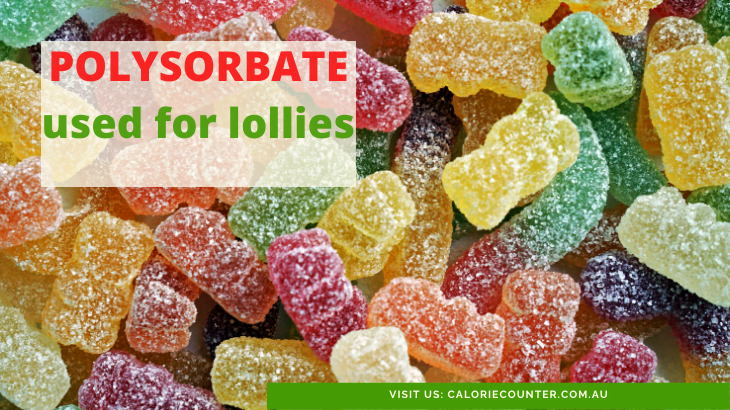
This class of emulsifier is versatile because their molecules form chain networks which smoothen textures and spread ingredients evenly. Polysorbate is particularly useful in foods with artificial flavours because it is a wetting agent which helps the flavours to spread in the mouth during chewing. It also makes temperature-sensitive ingredients less prone to melt.
Polysorbates have been linked with gut inflammation and cancer in mice.
Emulsifier 440: Pectin
Pectin is a naturally occurring dietary fibre found in many plants (apples are a rich source). At an industrial level, pectin is extracted from citrus fruits. Pectin is used extensively as a food additive, notably in jams, sauces, as it has been used for hundreds of years.
Emulsifier 441: Gelatin
Gelatine is a gel derived from the collagen in animal tissue. It has been used as a food additive for thousands of years.
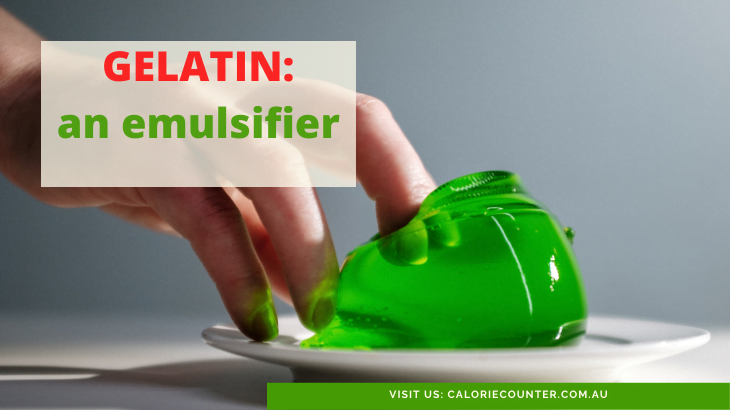
Emulsifier 442: Ammonium Phosphatides
Made from glycerol and vegetable oil, ammonium phosphatides is used as an alternative to lecithin in the chocolate industry.
Emulsifier 443: Brominated Vegetable Oil
Brominated vegetable oil, usually styled BVO, is made from vegetable oil and bromine, a halogen chemical element. BVO is used as an emulsifier in the food industry and a flame retardant in the plastics industry. It has been used in soft drinks since 1931, despite the clear and universally accepted understanding that excess consumption leads to bromism.
Bromism is a debilitating health condition caused by bromine. Bromine damages nerve structure and poisons the brain. Symptoms include restlessness, confusion, psychosis, ataxia, hallucinations, weakness and in some cases, coma. Some sufferers report nausea, anorexia, constipation, and vomiting. Headache, fatigue, memory loss and skin rashes are common misdiagnosed early symptoms.
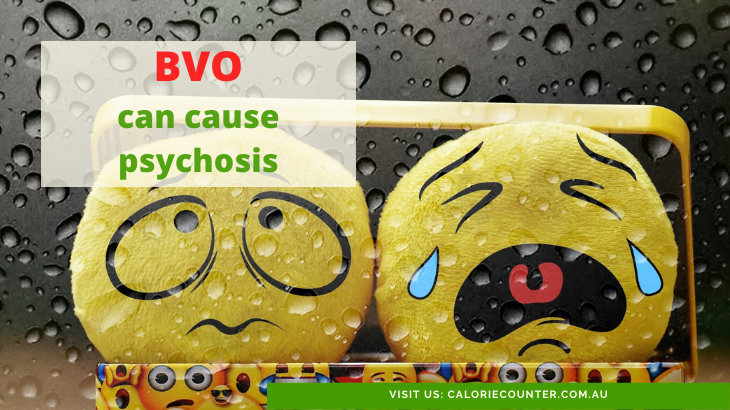
Emulsifier 444: Sucrose Acetate Isobutyrate
Sucrose acetate isobutyrate is made by a chemical reaction involving sugar, vinegar, and the acid found in rancid butter. It is a non-bromide alternative to BVO (see code 443).
Emulsifier 445: Glycerol Esters of Wood Rosins
Made by chemically reacting crude turpentine with glycerol/glycerine, glycerol esters of wood rosin is used in soft drinks in place of, or in combination with, BVO (see code 443). Crude turpentine, also known as wood rosin, is a by-product of the lumber industry.
Emulsifier 450, 450i, 450ii, 450iii, 450iv, 450v, 450vi, 450vii: Diphosphates
Also known as pyrophosphates, diphosphates are dissolvable metal salts which are used in many processed foods including whipped cream. Studies like this one show that diphosphates cause kidney damage.
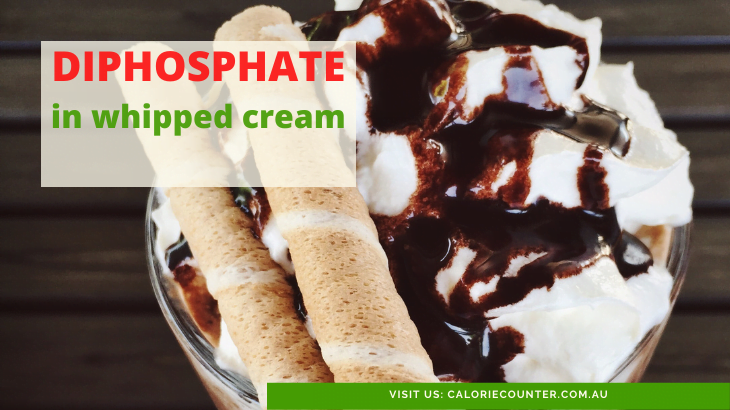
Emulsifier 451i, 450ii, 450iii, 450iv, 450v: Triphosphates
2 million tonnes of triphosphates are made each year through the industrial process of heating disodium phosphate and monosodium phosphate together. Triphosphates are used to make detergents and emulsify foods which need to retain moisture. High levels of triphosphates in the blood are a recognised predictor of heart attacks and early death.
Emulsifier 452i, 452ii, 452iii, 452iv, 452v: Polyphosphates
Polyphosphates are produced through a complicated industrial chemical process which involves carefully controlled reactions amongst a plethora of complex chemicals. According to the US FDA, the EU Scientific Committee on Food and others, they might not cause heart attacks and bone degradation if less than 40mg is consumed per day. But maybe they will. And please try not to eat more than 40mg per day.
Emulsifier 459: Beta-Cyclodextrin
Beta-cyclodextrin is a massive sugar molecule made by the action of enzymes on starch. They work as emulsifiers by linking to both oil and water at the same time, thus preventing an oil/water mixture from separating. Beta-cyclodextrin may damage kidneys in mice and cause hearing loss in humans.
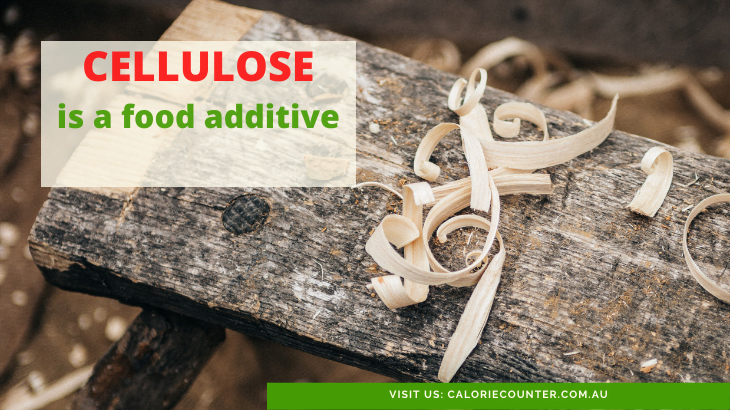
Emulsifier 460, 460i, 460ii, 461, 462, 463, 464, 465, 466, 467, 468, 469: Cellulose
Probably the oldest, safest, most widespread emulsifier in the world, cellulose is the main structural material used by plants. Think wood, the fibres in spinach, and the chewy parts of celery. Cellulose in its pure form and in several variations with chemical tweaks is used to emulsify a wide range of processed foods. Yes, sawdust is an emulsifying food additive.
Emulsifier 470a, 470b: Sodium, Potassium, Calcium, and Magnesium Salts of Fatty Acids
This group of “salts of fatty acids”, also known as soap, are emulsifier food additives. Yup, it is safe to add tiny amounts of soap to food for emulsification purposes. Straight-up stearate (stearic acid, the grandaddy of soaps) is also a food additive, code 570.
471: Mono and Diglycerides of Fatty Acids
The famous Emulsifier 471 is “Mono and Diglycerides of Fatty Acids”, in other words, “oil”. The only difference between the bottle of vegetable oil in your kitchen and a bottle of Emulsifier 471 is that your kitchen oil is mostly triglycerides, and the 471 is mostly monoglycerides and diglycerides.
To make 471 stabilizer, manufacturers put some specific enzymes to work on regular triglyceride oil.
Monoglycerides and Diglycerides are more hydrophobic than triglycerides – meaning they mix with water even less. Things coated with them become “waterproof” so that they can remain in mixture without dissolving, reacting, or separating, in other words they emulsify.
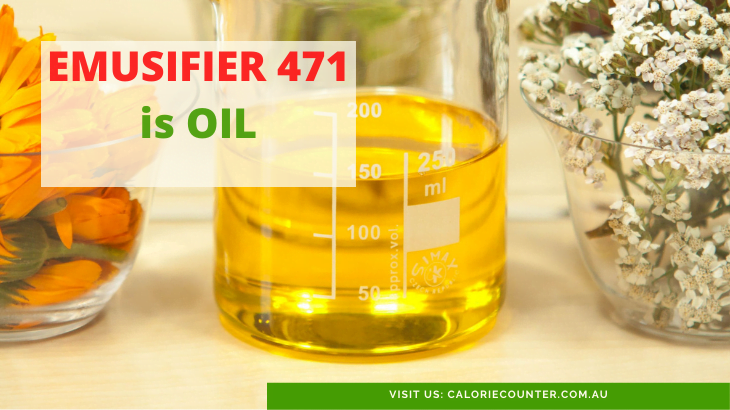
Unlike most of the other emulsifier food additives on this page, 471 covers a huge range of substances. There are about 50 different types of oil commercially used to make mono and diglycerides of fatty acids, each with an unlimited combination of mono, di, and polyglycerides.
But What is Emulsifier 471?
Therein lies one of the main health concerns with 471: you don’t know what you’re getting. The 471 could be made from pork fat or olive oil. It could be 20% coconut oil from a stinking 30-year-old vat, mixed in with the by-product of a tanning factory. All you will see on the label is: emulsifier (471).
Since 471 is simply oil, there is no limit to how much manufacturers can use in their recipes. Weight for weight, mono and diglycerides have about half the calories of regular triglyceride oil, but they still pack a hefty amount of food energy. The 471-coated fruit lumps in your cute pot of pink sweetened yoghurt might be delivering a quite different nutritional load from what you expect!
Emulsifier 472a, 472b, 472c, 472d, 472e, 472f, 472g: Esters of Mono and Diglycerdides of Fatty Acids
Your food label ingredients include Emulsifier 472e? Well, that is acidified 471. Esters of mono and diglycerides of fatty acids is the result of a chemical reaction between food additive code 471 and an acid (for example, citric acid produces 472c). These different esters perform similarly to 471, but with more specialised function. For example, 472e (mono and diacetyl tartaric acid esters of mono and diglycerides of fatty acids, better known as DATEM) is used to emulsify bread dough because it enhances gluten.
Emulsifier 473, 474, 475, 476, 477, 478, 479b: Products of Fatty Acids
This group of emulsifiers are the result of chemical reactions involving “regular” oil (not mono and diglycerides of fatty acids). For example, 473 is made from sugar (sucrose) and oil (usually vegetable oil). 477 is a combination of propane (yes, barbecue gas) and oil. These lab-born emulsifiers are formulated to perform specialised, multi-objective tasks in processed foods and other industries.
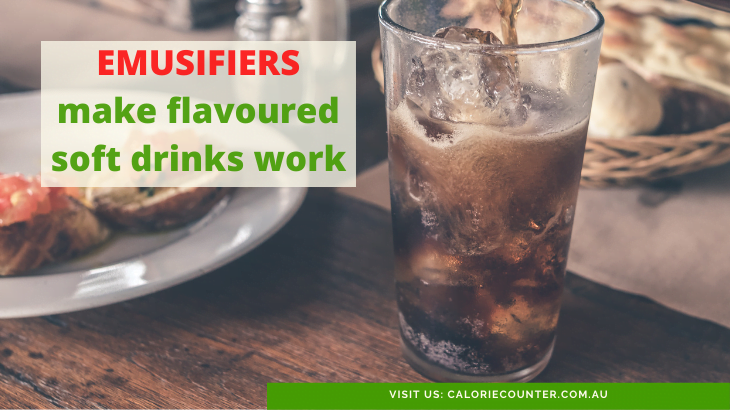
Emulsifier 480: Dioctyl Sodium Sulfosuccinate
Additive 480 was born in 1937 as an aerosol detergent. Better known as Docusate, dioctyl sodium sulfosuccinate is a salt often added to cheese spreads, carbonated soft drinks, and salad dressings. It has a strong laxative effect and long term consumption causes poor bowel function.
Emulsifier 481, 482: Stearoyl-2-Lactylate
481 and 482 (commonly known as SSL and CSL) are stearoyl-2-lactylates of sodium and calcium, respectively. Lactylates are a family of chemicals developed in the 1950s for the specific purpose of increasing the shelf life of bread. The recommended safe daily consumption of 481 and 482 is 22.1mg/kg of body weight.
Emulsifier 483: Stearyl Tartrate
Stearyl tartrate is a deceptive food additive in that it could be any or all of three different esters (distearyl tartrate, dipalmityl tartrate, and stearyl palmityl tartrate). It is not approved in Australia due to concerns that it may be a carcinogen (causes cancer). Check the label on imported foods, and when you are overseas!
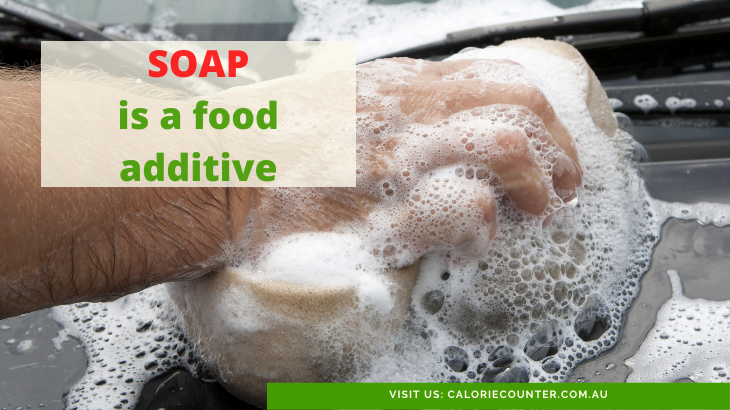
Emulsifier 487: Sodium Lauryl Sulfate
Usually, the prime lathering ingredient of shampoo and handwash, sodium lauryl sulphate sometimes spelled sulphate and called sodium dodecyl sulfate or SLS) is also an emulsifying food additive.
Emulsifier 490, 1520: Propane-1, 2-diol
Also known as propylene glycol, propane-1,2-diol is produced in the millions of tonnes each year from petroleum. It is mainly used to make plastics, but it has many other industrial uses, including as an emulsifying food additive. It is also an indirect food additive when used for its solvent and antifreeze properties in mass food processing.

Emulsifier 491, 492, 493, 494, 495: Sorbitan
This group of emulsifiers are compounds of sorbitan, which like polysorbate (see codes 432-436) is a derivation of sorbitol (code 420). Sorbitan widely used, particularly 492 (sorbitan tristearate) sold under brand names like Alkest, Span, and Canarcel.
Emulsifier 499: Stigmasterol-Rich Plant Sterols
Stigmasterol-rich plant sterols, like all phytosterols, are in the group of chemicals which functionally mimic cholesterol in humans. It is not a “pure” chemical, rather a mixture of at least four different phytosterols. Used in frozen foods, it is extracted from soybeans at an industrial level. Some research shows that elevated levels of plant sterols increases the risk of heart disease.
Emulsifier 471 is oil, Gellan Gum is made by bacteria
So emulsifier 471 is oil, Gellan Gum is made by proprietary bacteria, and glorified wood shavings are certified food additives. Yup, there’s more than meets the eye when you look closely at what’s really in processed foods! Fortunately, most of the emulsifiers on this list will not harm your health and many might even enhance it. Just be sure to balance your intake of processed foods with lots of fresh, whole, unadulterated, natural food. Then, record what you eat in your calorie tracker!

